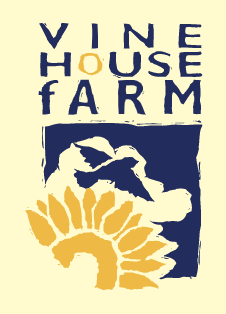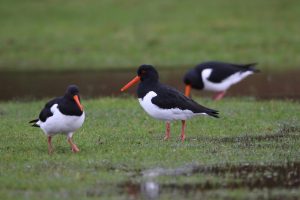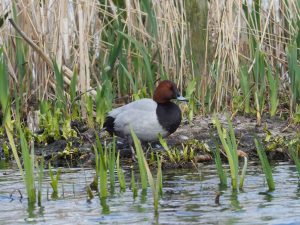
September was an average month here; with less wind than normal and slightly above average rainfall, 48mm or 1.9ins. It was also the second warmest September since 1970. Can you remember last year? It was the second coldest September since 1970 – the year that I started recording the weather. The rain has fallen on dry ground, so has not hindered our land work.

Our farm workers try not to take any holidays in August, September and October and they all work overtime, as it is our busiest time of year.
It has been a catchy time since late August, with intermittent rain, which made the wheat harvest run into early September. The wheat harvest was better than expected however; we weren’t expecting it to be very good, due to all the rain that fell upon us in June. Every plant needs sunshine when it is in flower, to produce a good crop of seed. You might question whether Wheat produces a flower; it doesn’t, but it does produce anthers, on which there is a small amount of pollen, and like many plants, it is self-pollinating. The canary seed harvest followed the Wheat, then the red millet, the white millet and finally the sunflowers. This year, we had a sunny July and August, so our canary seed and millets have done well. Millet is a vulnerable crop as, if we get strong winds, it can shed seeds so they will drop to the floor before we get to harvest them.
Another unusual harvest we have is the red clover, which is a two year crop grown on the organic land at Vine House Farm as a fertility building crop. It is drilled in April then, during the summer of the same year, we cut it to stop weeds seeding and the clover from going into flower. Clover is an indeterminate plant – its flowers don’t appear all at once, which makes a good harvest nigh impossible. So at the end of May, in the second year, we cut it down which makes the plants produce a lot of flowers all at once. We can then get a good harvest from it in early September, depending on the sunshine and the amount of pollinators that visit the flowers.
We started harvesting potatoes mid-September; crops are about, or slightly below, average. Prices are quite good for those not on contracts – we are getting £190/tonne on the farm for potatoes going to Morrison, and prices are expected to remain good for the rest of the season. The potato harvest is our longest harvest; we expect it to continue for most of October. Most of what we harvest will go into store, which will then have to be checked regularly to make sure they are at the correct temperature and the potatoes are keeping all right. Some growers store potatoes in a big heap, maybe 500 tonne or more, in the one building. Others, like us, keep them in one tonne boxes – generally they keep better this way, but of course there is the additional cost of the boxes. These cost more than £55 each, but can last for 30 years.


Voles are about in good numbers in South Lincolnshire, which is why we are not seeing any Barn Owls flying about in the day.
Three pairs of Barn Owls, that I know of on our farm, are having a second brood and they all have four or more chicks. Where Barn Owls nest in barns, they often have their second brood tucked away in a corner, leaving their first brood to grow up in the original nest place. So there may well be another brood, or two, that we haven’t found. How many of us would go and live elsewhere leaving our children to grow up in our house?! This year, 14 pairs of Barn Owls have successfully reared chicks on our farms.
We have been busy putting up more Tree Sparrow boxes. One of my neighbours had an old irrigation reel, with 300 metres of thick plastic pipe. It is a nightmare to recycle, so we were able to take 100 metres of this pipe, cut it into 2m lengths and use as posts for hanging the nest boxes on. The only drawback is that we can’t straighten the plastic post, so each one is slightly curved.
So we now have about 150 concrete nest boxes on either concrete or plastic posts, which should last for 40 years. It is possible for weasels to climb the concrete posts; whether they could climb the plastic posts I don’t know, only time will tell. In the future I will need someone to carry on my Tree Sparrow nest box monitoring. Is there anyone who would like to help me in 2017?
We haven’t purchased, or made, any wooden nest boxes this year. We have mainly used Woodstone, and a few Woodcrete boxes which have a guarantee of 25 years, they don’t have any hinges on them that may seize up, and only cost 50% more than a wooden box. All the boxes have all been placed on posts or on walls. If we place them on a tree, the growing tree will eventually eject them and you come one day to find the box on the ground.
We have been round all 110 nest boxes and cleaned them out. The old nests need cleaning out because they could contain parasites which could feed on the young – or even the adults. We have guidelines on how to attract Tree Sparrows which can be found on our website. It is unusual to find them in a town garden but if anyone has been lucky enough to have them in their town garden, perhaps you could let me know?
Ravens are back on the farm, we have seen them during the last two winters but they have not stopped to breed. I suppose it is only a matter of time before a pair breeds on a big bale stack somewhere in the fen. Ravens have been one of the species to benefit from the rearing of pheasants. All my lifetime they have been a bird of the upland areas in the west, but over the last 30 years they have come from west to east. This is because they’ve had a surplus of food during the autumn and winter, enabling a good survival rate of the young birds.
Visit Taylors Bulbs for their Charity Bulb Sale on Friday 4th November 10am – 4pm Washway Road, Holbeach
Over the next month I will be giving talks to:
20th Oct The Womens’ Institute, Dyke Village Hall
21st Oct The Farmers Club, Country Club, Boston
27th Oct Frampton Gardening Club, near Boston
A future date for your diary is the The Lincolnshire Wildlife Trust Coffee Morning at Pinchbeck on 12th November



